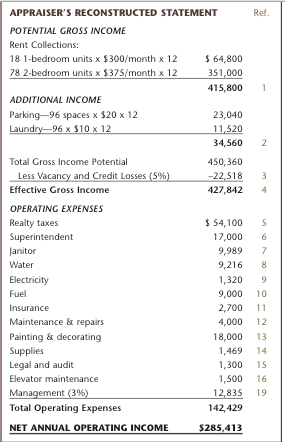So, how do we work our magic and reconstruct a marina’s operating statement? Assuming we get the QuickBooks file, we start by copying/renaming it. Working with the copied version, we pour over each line item and see how it’s categorized (never overwrite the original). We categorize according to a preset list we use internally that’s based on marinas we’ve appraised with exceptional accounting systems.
 But that’s only the beginning. Many expenses can be separated into business and real estate components. For instance, repairs and maintenance would be real estate and items that are part of cost of goods sold are business. It then falls on us to query the owner or accountant to find out more about expenses that are nebulous in origin and purpose. Also, we can often get a handle on the percentage of a commonly shared expense that’s allocated to real estate and business (such as 70 percent business, 30 percent real estate).
But that’s only the beginning. Many expenses can be separated into business and real estate components. For instance, repairs and maintenance would be real estate and items that are part of cost of goods sold are business. It then falls on us to query the owner or accountant to find out more about expenses that are nebulous in origin and purpose. Also, we can often get a handle on the percentage of a commonly shared expense that’s allocated to real estate and business (such as 70 percent business, 30 percent real estate).
Some items on the financial statements need parsing. The owner’s personal boat, car and family members on the payroll, when present, are excluded. Some items that are shown may not be arm’s-length such as when a marina owner owns part of a business and yet shows a line item for rent. If it’s not arm’s-length, we can’t include it. Some items are excluded altogether as not being “operating expenses”. For instance, depreciation and charity would not be included.
So now we have a reconstructed operating statement… or do we? The last bit of “forensic” analysis we do is to determine how regular the patterns are. That’s where reconstructing more than one operating statement becomes handy. Maybe repairs and maintenance are skewed higher due to a capital expense that is “expensed” the first year. Maybe insurance is due in the fourth quarter of the year and was not paid until the first quarter of the following year. Perhaps some extraneous event caused certain expenses to be skewed. Maybe management was aggressive about reducing insurance costs and changed vendors. Maybe there was key personnel turnover in management or accounting. Perhaps a bad storm damaged the marina and revenue was down for that year. The list is long, but the key is to examine the patterns and see where they vary.
After understanding variations you reconcile them into what is termed a “stabilized” operating statement. Ah, but you’re not done yet! Take a look at the operating expense ratio. Is it in line with market? Is it reasonable for this property type? An operating expense ratio that is the same as what a triple-net industrial building would incur or that of a fully leased office building means there’s a flaw in there somewhere. Marinas have expenses typical investment real estate does not, such as owner’s salary, payroll, payroll taxes, health insurance premiums, bad debts, Visa/MasterCard/American Express charges and profit sharing.
So now we have a credible stabilized operating statement (USPAP is smiling at us now). Net operating income divided by the cap rate equals market value via the income approach. And we’re done. After pouring over the hundreds of accounting line items, telephone calls to the owner and/or accountant, and comparing the operating expense ratio to other comparable marinas or industry averages, let’s hope we got paid for all this work.
I never said that appraising a marina was an easy job.

